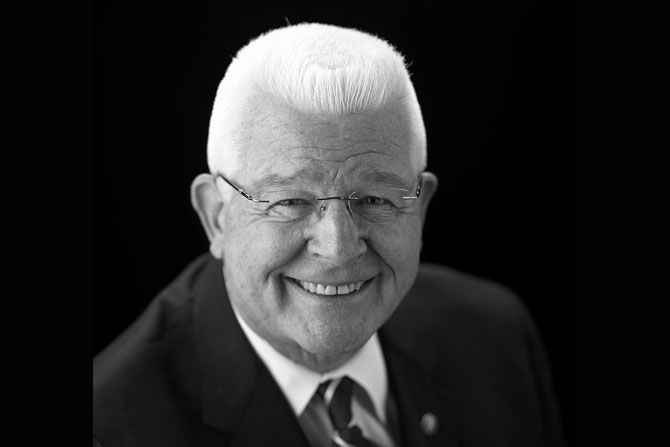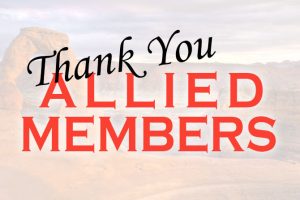Mike Stransky is a Wyoming native with a big, open personality. Mike originally came to Utah to go to architecture school. After a nine-year stint with the Army Reserve and Don Panushka’s firm, Mike joined Abe Gillies in a firm that would evolve to be GSBS, now one of the standard-bearers in the Utah architectural industry. Mike talked to Fran Pruyn and Travis Shephard, AIA, about his career in the industry.
When did you decide to become an architect?
While I was in high school in Wyoming. I thought about petroleum engineering; Wyoming is full of oil and uranium. I also thought about a military career. I applied to the Merchant Marine Academy and took the physicals, and found out I was color blind. No academy would take you if you were color blind. So, my family encouraged me to consider architecture because I liked to draw and make things. I took drafting classes in high school and pretty much made the decision. I didn’t know where to go; I didn’t know a lot about architecture other than drawing and building involved with it.
So, where did you go from there?
I went to a community college in Casper to get my university requirements. I had a teacher who lined me up with Mr. Wehrle, an architect. I found out he was at the University of Utah doing a doctorate in architectural psychology. I thought, well, Utah is good for him, Utah is good for me, so I applied, was accepted, and came to the University of Utah in 1964.
Clearly, you graduated then …
(Smiles) Not without a struggle. I got drafted in ‘67. So, to accommodate both careers, I opted to go into ROTC at the University, which gave me two years to finish. I graduated in ‘70, got my commission, and had to go into the Army.
Where were you stationed?
I was in the Army Corps of Engineers, and the training is in Ft. Belvoir, Virginia. Carolyn and I had been married for two years. She put her career on hold because I didn’t have an option. My option was to go to Ft. Belvoir and then to Vietnam, but they were cutting back, so I wasn’t shipped out to Vietnam. I spent nine years in the Army Reserves in Utah. At the same time, I worked for Don Panushka before deciding to jump in with Abe Gillies.
Tell us about that.
I knew Abe in school; he was one year ahead of me. He had a partner – Bob Brotherton. They had worked together at Enteleke and had decided to do it on their own. They incorporated in January of 1978. They were looking for help, and I was looking to move on. My firm wasn’t considering longevity and transition. I said, “I am interested but not just in a job.” Within a year, I had bought into the firm. Within two years, Bob wanted to stay in our office in Denver, so we split then. That is when it became Gillies Stransky. Outside of marrying Carolyn, it was the best action I ever took – to accept his invitation to join him in business. He is the best. He plowed the ground; I joined the team. Pretty soon, I found out that we both had a heckuva load of responsibilities.
How did you divide the responsibilities?
We did everything. Abe had been involved in putting the corporation together, so he kept an eye on the books and the billings. I was largely involved with project management. There was a $15 million job with Wheeler Machinery; a really good job for our little firm — incredible clients. As a result of that job, we picked up a very similar project in Denver, Wagner Equipment — another great client. That’s when Bob decided to open an office in Denver doing interior finishes, largely.
We picked up similar jobs. I ran projects. Abe ran the business and ran projects too. I started doing the marketing; I was the outside guy. Abe said, “You be AIA for the firm; I’ll take care of this. I’ll be the ballast.” Great person, great ballast. I can’t imagine having a better partner.
A couple of years later, through AIA, I got to know David. I knew Steve before, a little bit; he was a neighbor of Abe’s. We brought our firms and talents together. By 1986, we got all the initials in there.
Talk about some of the struggles.
When you are starting your firm, having a strong financial basis is important. We mortgaged my house; we dipped into my savings to pay some bills. I had a lot of cold showers. It was the kind of “the-head-against-the-wall” thinking, “We gotta get through this.” But you still believe in yourself. And you believe in your partner. And my wife believed in me. She lived through that stuff; it was as tough a time for her as it was for me. But we knew we could do it. We never missed a payroll. Never. I am really proud of having done that. Never stepped on anyone to make that happen. No consultant ever went unpaid.
The work was never too hard. It was grueling at times, trying to get work done, trying to figure out how to get the new job to keep a flow of projects into the office. Those are struggles, but those are all just meaningful moments in your career. You just find a way and make it happen.
When you look at your career, what are you most proud of – both in the practice and portfolio?
Recently, I tried to figure out how many jobs I had worked on. I had over 800 projects that I was responsible for. Now that’s a tenant finish, but it is also a big federal project. That is a pretty wide spectrum. When you do that, you meet those clients. Some of the joy of the projects was the clients, having a relationship with them, not necessarily the end result. People were always, to me, important.
I am proud of the Museum of Natural History that the firm did, but I didn’t personally spend a lot of time on it. As a piece of architecture, it is unquestionably one of the best things our firm was involved in, teamed with Ennead.
I like St. Thomas More. That was a big struggle to get that built. The building committee, people from the east, west, south – all had their backgrounds that they brought to the table. Sorting that out you would think is relatively easy (but not); this is only a couple of million bucks. I am incredibly proud of that project. I think it is a landmark project for the Catholic Church. It was an aggressive look at what a church could be, not the repeat of a church in Indiana, or Savannah, or Upstate New York, or Tucson. It is Salt Lake City, Utah; it is very contextual.
I love the Public Safety Building. I think it was a progressive step for our firm, working with David and Kevin and Valerie and all of my great partners to get that done. I think we succeeded in a tremendous way.
Abe said that you enjoy doing Maintenance Facilities because they are so technical and require so much thought.
The first big job I worked on with Abe was Wheeler Machinery. I had just worked on the University Hospital for Don Panushka. All the details from the hospital — the radiation, the labs, the plumbing for gasses and air — everything was really technical, and I really got my head into that. Then it just fit it in to do Wheeler. There is infrastructure in there that I loved putting together, although the scale of that was monster, not microscopic. We grew that into doing work for the federal government, largely the Corps of Engineers in Sacramento.
I did a lot of work with them. I sought those as hard as any other job that we sought. It was very successful work. The Consolidated Maintenance Facility we did at Tooele Army Depot was a $120 million fully rigged outbuilding for rehabbing military vehicles, engines. The heartbreaker was that within two years after that was finished, Tooele suffered from the base closures, and they sold it to a private client for ten cents on the dollar. But that’s politics.
Tell us about the evolution of the industry from the late sixties till now.
There were firms that were emerging. Many of the old firms went away. Only a few of them had transition plans that allowed them to continue until today. There are only three or four that proceeded us — MHTN, EDA, FFKR — Bob Fowler had his own firm, and the Enteleke guys came over. Most of the other firms went away; they didn’t put transition in place.
I remember my boss Don Panushka, calling when he finally retired, and he had a bunch of drafting boards and asked if we needed any. But we were already on our second or third generation of computers. We embraced that from the very beginning, and there were a number of jobs we got because we could demonstrate we had that technology. We were then pressed with making it work, literally forced to make that technology work for us.
That is one thing that I personally didn’t embrace. I never felt I had the time to dedicate. I have fifteen calls to make, and I am not going to sit here at this computer and learn how to draft. In retrospect, that doesn’t bother me a bit. We have so many bright people who do that and far surpass anything I would do. Which is a bit counter to the way I looked at life. I always said, “If I have to drop back, if we have to lose every person in this firm, can I still do it?” Well, yeah, but I would have survived with pencil and paper or ink and paper.
In the last ten or fifteen years, I have watched dozens of firms do the same things we did, different ways and different people, and build excellent firms. I think we have an incredible community of architects that can meet any challenge. I am disappointed to see some of this work come to town being done by outside firms. The contractors who grew along with us are (mostly) able to build these. But they are not looking to our community for our design. There is plenty of work going on, everybody is busy, but when I see some of the tallest buildings downtown, I’d like to see that we are, or somebody else, is doing them, not some firm from somewhere else in the country.
What do you think makes a good building, and can you name a few really good buildings in Utah?
The City and County Building. I am glad we saved it. I was chair of the Landmark Committee when there were discussions about what was going to happen with that building. They had to come up with $35 million, and many people said tear it down, build us a new building like the Church Office Building. There wasn’t a lot of traction there, but this was presented. We finally grew as a community to say we are saving these treasures.
- And, of course, the Capitol; it has gone through a major renovation, and it is going to be here for a long, long time
to come. - In my own faith, the Cathedral of the Madeleine is a jewel of this community.
- One that always comes to mind is Symphony Hall. That one has stood the test of time. I think its context makes that a great building.
- The context of the Natural History Museum makes that a great building.
- A GSBS project, the Speed Skating Oval: I think that is world-class architecture. It fulfilled its mission in 2002.
- The Public Safety Building is a favorite of mine.
If I went back and asked what made them great, I think: how did the project go with the client and the people it represents? Did some of those get designed and built in spite of the client? I never believed in that.
What would you say to someone following in your footsteps quite literally and wants the class, style and composure you guys had?
It is time for you to make it your own. This profession changes, personalities change, our community changes, clients are changing.
Advice for a young architect?
Architecture is a tough profession, particularly as a young practitioner. You are going to school, you wonder how to apply what you have learned, is the economy going to accept you? Is there going to be anything left by the time I have put in my seven years? It is a profession that can leave you hanging for a year or two while the economy takes a dip.
You have to be ready to say, “This is what I want to do; I see my niche,” and you give it everything you’ve got, because it will suck up everything you got – all your time, all your energy – if you let it. And then you will find that you have to balance that with your other life, your family: your partner, your spouse. And you have to find a way to keep that in balance. That will probably be the biggest struggle you’ll have.
Last thoughts?
My job was to go out and to create a presence in the community. I hadn’t been a member of the AIA. So, I became an AIA member, an active one, and expanded that to some pretty healthy responsibilities within the AIA – the National Board, Board of NAAB, 18 years on the Documents Committee. And through that, I was able to help accomplish a lot for the profession on a national basis. While that was all happening, I met hundreds of men and women across the country with whom I got to share my experience and they with me. A number of those we partnered with on work because we had mutual respect for one another, and they brought something to the table that we didn’t have. I cherish that part of my career. Very much. It was something that my wife shares with me, and she has friends within that circle of professionals that we still have today. It. That was a big part of my life. It was very rewarding.
To watch the full interview, please click below.
https://www.youtube.com/watch?v=G0OrK1jKvKo






